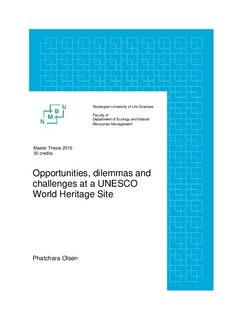| dc.description.abstract | One of the missions of UNESCO World Heritage is to ensure the protection of the cultural and natural heritage that are inscripted on the World Heritage List. Bryggen was inscripted on the World Heritage List in 1979, along with Urnes Stave Church. These are the first World Heritage in Norway. Due to the history of locals’ attitude against Bryggen from the past; the news articles stating that Bryggen is sinking; and the latest political discussion about making Bryggen as car-free zones by replacing transportation with light trains, questions about World Heritage management at Bryggen arise. In addition that Bryggen is one of the first World Heritage in Norway, and yet there has not been done any research concerning management at Bryggen. Therefore, this thesis provides a new research aiming for the management in Bryggen, relating to opportunities, dilemmas, challenges and potential conflicts that the site managers face with an insight of the tourism industry as well.
In this thesis qualitative method is applied, with descriptive design and deductive analysis approach to collect the data. There are six informants, who attend in the in-depth interviews. The interview guide was prepared in beforehand based on the research question. Both interview guide and the interview process are semi-structured, with a limited time to approximately one hour. From the transcription, 11 topics are created to select and sort out the relevant data: (1) the impact of the UNESCO status; (2) Opportunities; (3) Challenges; (4) Obstacles; (5) Dilemmas; (6) Development; (7) Relationship to tourism; (8) Potential conflicts; (9) In 20 years; (10) Opportunities in 20 years; (11) Challenges in 20 years. Some of these topics are chosen and used in discussion, in order to narrow the focus of discussion even more.
According to the benefits and the advantages that UNESCO World Heritage claims, are found in Bergen. The site managers at Bryggen face many challenges and dilemmas. Some of them are controllable, and some are not. Additionally, it seems like there is lack of communication and cooperation between the management and the tourism industry. It appears that tourism industry is operating on its own, for their benefits. However, it seems that the managers are aware of all the challenges and dilemmas at Bryggen, and that they work continuously to find solutions to solve those problems. The finding shows and proves the importance of UNESCO World Heritage, how crucial it is to conserve and protect the heritage sites for the humanity and for the future generations. The finding also gives the insight of what dilemmas and challenges the site managers at Bryggen are facing, and how they handle them. | nb_NO |

